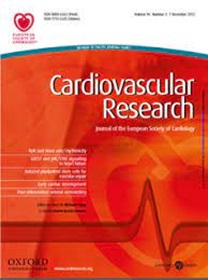S913 phosphorylation of Ulk1 protects the heart from aging through inhibition of cardiac senescence.
IF 13.3
1区 医学
Q1 CARDIAC & CARDIOVASCULAR SYSTEMS
引用次数: 0
Abstract
AIMS We have previously shown that prevention of GSK-3β inactivation with GSK-3β (S9A), stimulates autophagy through phosphorylation of Ulk1 at Ser913. In the current study, we investigated whether cardiac aging is accelerated in Ulk1S913A knock in mice and whether cardiomyocyte senescence plays an important role in the development of aging cardiomyopathy in these mice. METHODS AND RESULTS In systemic heterozygous Ulk1S913A knock in mice (shS913A), cardiac dysfunction (evidenced by lower ejection fraction and fractional shortening, lower dP/dtmaximum, higher end-diastolic pressure and higher dP/dtminimum) and fibrosis, along with increased cardiomyocyte senescence (increased P16, P21, IL6, γH2AX, and P53), were observed at 18 months old. RNA-seq analysis showed that numerous genes are differentially expressed in shS913A and littermate wild type (WT) hearts, including those involved in glucose metabolism, cardiac fibrosis, and cellular senescence. The glycolytic activity was higher in adult mouse cardiomyocytes isolated from shS913A than in those from littermate WT mice. In cultured neonatal rat ventricular cardiomyocytes, overexpression of Ulk1S912A induced cellular senescence. Heterozygous cardiac-specific Ulk1S913A knock in mice (chS913A) developed cardiac dysfunction, hypertrophy, fibrosis, and senescence at 7 months old. ABT-263 treatment (senolysis) attenuated the cardiac dysfunction, hypertrophy, and fibrosis while decreasing the number of γH2AX-positive cardiomyocytes. CONCLUSIONS The chS913A mice exhibit premature cardiac aging, which is mediated through stimulation of cardiomyocyte senescence. The results support the role of the GSK-3β-Ulk1-autophagy pathway in the heart during aging. Thus, these mice could be useful in studying cardiac aging and senescence.Ulk1的S913磷酸化通过抑制心脏衰老来保护心脏免受衰老。
我们之前已经证明,GSK-3β (S9A)通过Ulk1 Ser913位点的磷酸化来预防GSK-3β失活,从而刺激自噬。在本研究中,我们研究了小鼠Ulk1S913A敲入是否会加速心脏衰老,以及心肌细胞衰老是否在这些小鼠衰老性心肌病的发展中起重要作用。方法和结果在18个月大的小鼠中,观察到全身杂合子Ulk1S913A敲除(shS913A),心功能障碍(表现为射血分数降低和分数缩短,dP/dtmaximum降低,舒张末期压升高和dP/dtminimum升高)和纤维化,以及心肌细胞衰老增加(P16, P21, IL6, γH2AX和P53增加)。RNA-seq分析显示,许多基因在shS913A和同窝野生型(WT)心脏中存在差异表达,包括与葡萄糖代谢、心脏纤维化和细胞衰老有关的基因。从shS913A分离的成年小鼠心肌细胞的糖酵解活性高于同窝的WT小鼠。在培养的新生大鼠心室心肌细胞中,Ulk1S912A的过表达诱导细胞衰老。杂合子心脏特异性Ulk1S913A敲敲小鼠(chS913A)在7个月大时出现心功能障碍、肥厚、纤维化和衰老。ABT-263治疗(senolysis)减轻了心功能障碍、肥厚和纤维化,同时减少了γ h2ax阳性心肌细胞的数量。结论chS913A小鼠出现心脏早衰,其机制可能与刺激心肌细胞衰老有关。这些结果支持gsk -3β- ulk1自噬通路在衰老过程中心脏中的作用。因此,这些小鼠可以用于研究心脏老化和衰老。
本文章由计算机程序翻译,如有差异,请以英文原文为准。
求助全文
约1分钟内获得全文
求助全文
来源期刊

Cardiovascular Research
医学-心血管系统
CiteScore
21.50
自引率
3.70%
发文量
547
审稿时长
1 months
期刊介绍:
Cardiovascular Research
Journal Overview:
International journal of the European Society of Cardiology
Focuses on basic and translational research in cardiology and cardiovascular biology
Aims to enhance insight into cardiovascular disease mechanisms and innovation prospects
Submission Criteria:
Welcomes papers covering molecular, sub-cellular, cellular, organ, and organism levels
Accepts clinical proof-of-concept and translational studies
Manuscripts expected to provide significant contribution to cardiovascular biology and diseases
 求助内容:
求助内容: 应助结果提醒方式:
应助结果提醒方式:


